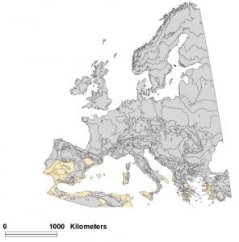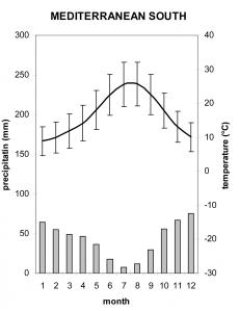
Mediterranean South (MDS)
The description of this zone is restricted to the European part of the Mediterranean.The Environmental zone Mediterranean South occupies plains and uplands in southern Mediterranean and some lowlands in the northern.

Most of the zone is in the Iberian peninsula, where relief consists of plateaus with residual mountains, denudational plains and accumulative lowlands. Climate is Mediterranean with hot and dry summer and maximum of precipitations in winter. Growing season lasts 363 days (363-365), sum of active temperatures is 6021°C (5904°-6578°).

The Sierra-Morena, West Corsica, East Sardinia and partly the Catalonian coast are Hercynides. The southern segment of the Catalonian coast, Lower Rhône and West Sardia belong to the mantle of Epi-Palaeozoic platform; other segments belong to the Alpine folding.
Dominating geological formations are: Carboniferous (Algarve), Pre-Cambrian with Palaeozoic acidic and intermediate intrusions, Ordovician+Silurian (Alentejo), Cambrian with Palaeozoic acidic and intermediate intrusions (Sierra-Morena), Palaeozoic acidic and intermediate magmatic rocks (East Sardinia, Corsica), Cretaceous (Kreta), Palaeocene and Eocene (South Peloponnesus) and Miocene (South Mallorca) formations and undifferentiated Neocene (Albanian Lowland
The vegetation is dominated by a variety of scrub formations (maquis, garrigue, phrygana, sjibljak). Agriculture is partly in a phase of abandonment, partly intensifying. Major products are wheat, wine, olives and fruits. In the western parts of this zone dehesas and montados are important landscape structures. Here the main production zone in the world of cork is situated in this zone (Quercus suber).
